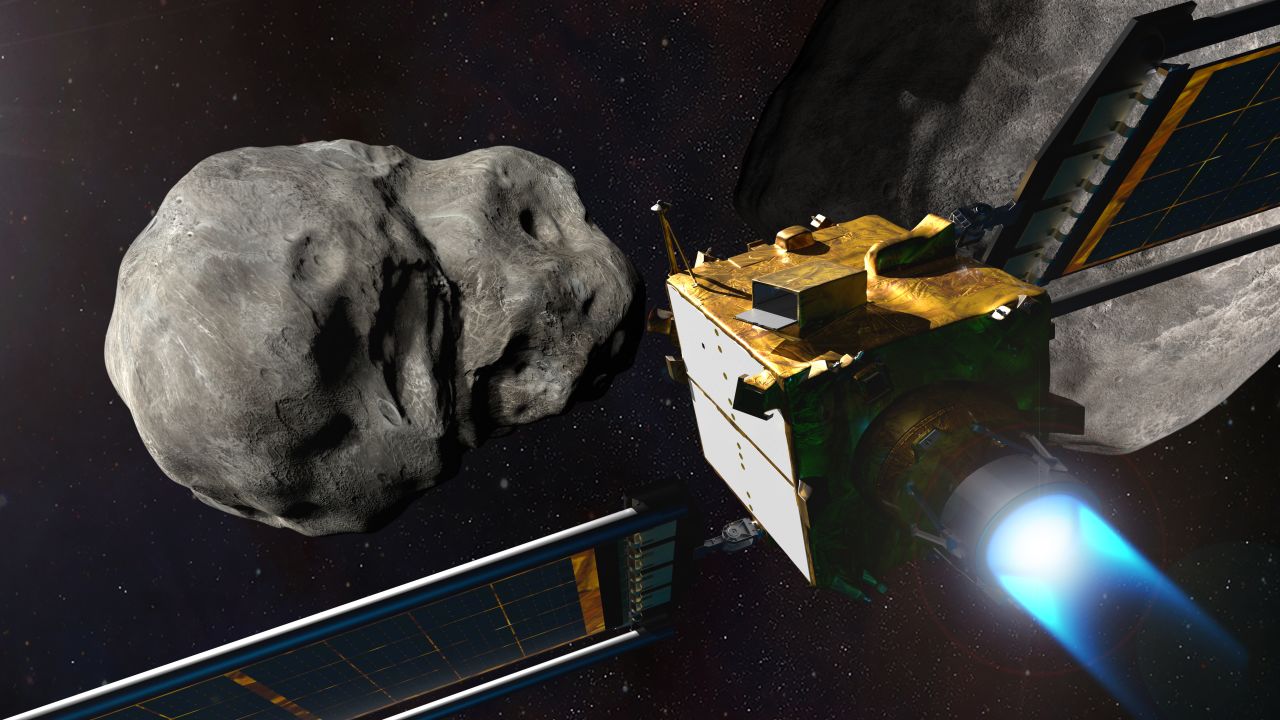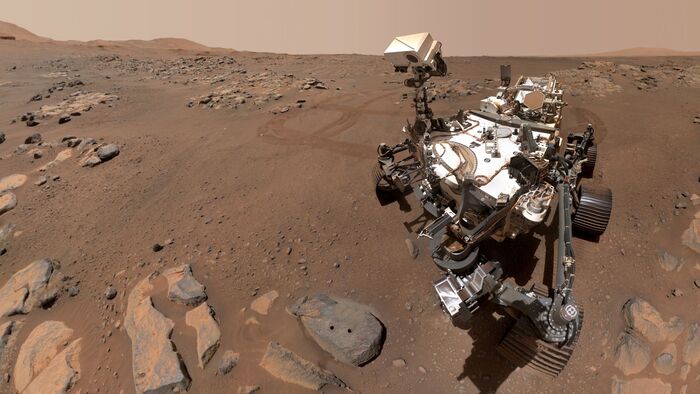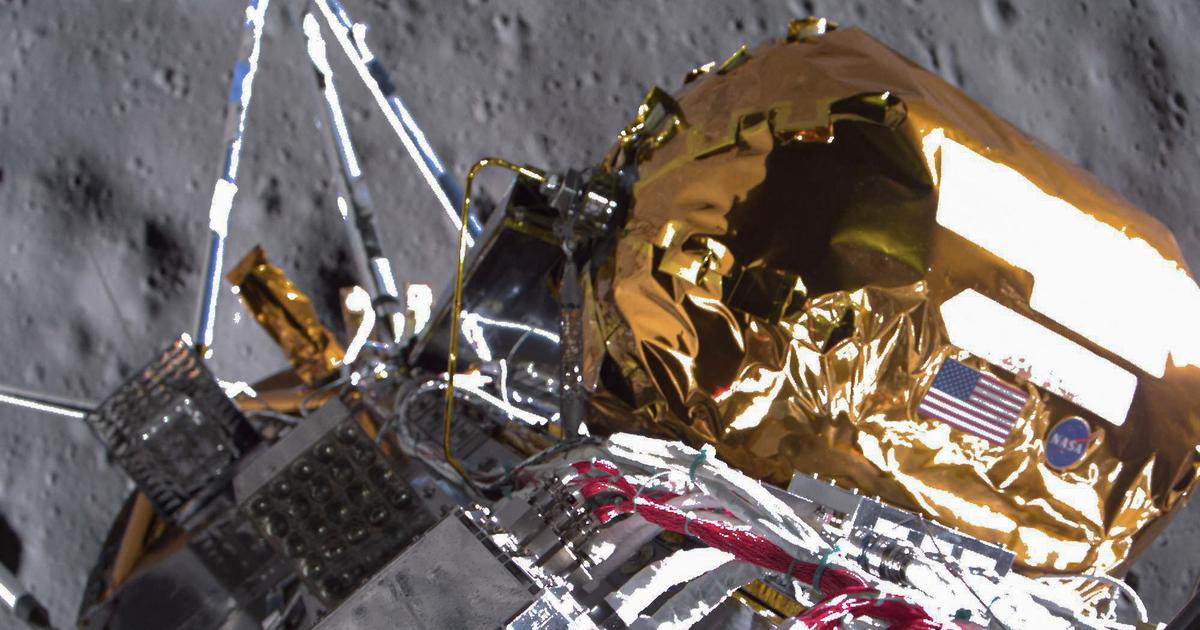NASA explains how the DART mission would prevent an "Armageddon" 2:30
(CNN) --
A NASA spacecraft will deliberately crash into an asteroid called Dimorphos on Monday.
The DART mission, or Double Asteroid Redirection Test, aims to test whether this type of kinetic impact can help deflect an asteroid that poses a threat to Earth.
This illustration shows the DART spacecraft heading for the asteroid Dimorphos.
Credit: John Hopkins APL/NASA
"We will deflect an asteroid," said Tom Statler, NASA's program scientist for the DART mission.
"We will change the movement of a natural celestial body in space. Humanity has never done that before."
Here's what you need to know about this mission.
What is DART?
The DART spacecraft is the size of a school bus.
It has been traveling to reach its asteroid target since its launch in November 2021. The spacecraft will arrive in the asteroid system on September 26.
Impact is expected at 7:14 pm (Miami time).
advertising
Where is it headed?
The spacecraft is headed for a double asteroid system, where a small "moon" asteroid, called Dimorphos, orbits a larger asteroid, Didymos.
Didymos, which means "twin" in Greek, is approximately 780 meters in diameter.
Meanwhile, Dimorphos measures about 160 meters in diameter, and its name means "two forms".
At the moment of impact, Didymos and Dimorphos will be relatively close to Earth, about 11 million kilometers away.
Neither Dimorphos nor Didymos pose a risk of collision with Earth, neither before nor after the mission.
The DART mission is "a light of hope" if an asteroid were to come towards Earth: what you should know
What will DART do?
DART will have a heroic ending: it will set its sights on Dimorphos, accelerate to about 13,000 miles per hour, and slam into the moon almost head-on.
The ship is about 100 times smaller than Dimorphos, so it is not capable of destroying the asteroid.
Instead, DART will try to change its speed and trajectory.
The mission team has likened this collision to that of a golf cart slamming into one of the Great Pyramids: barely enough energy to leave an impact crater.
The impact will change Dimorphos' speed by 1% while orbiting Didymos.
It doesn't sound like much, but doing so will change the orbital period of that moon.
The push will slightly displace Dimorphos and further tighten its gravitational lock with Didymos, so the collision will not change the binary system's trajectory around Earth or increase its chances of becoming a threat to our planet.
What can we see?
The spacecraft will share its view of the double-asteroid system through an instrument known as the Didymos Optical Navigation and Reconnaissance Camera, or DRACO.
This sensor, which acts as the eyes of the DART, will allow the spacecraft to identify the double asteroid system and distinguish the space object with which it must collide.
This instrument is also a high-resolution camera that aims to capture images of the two asteroids to transmit them to Earth at a rate of one image per second in what will almost seem like a video.
You will be able to watch the live broadcast on NASA's website, starting at 6:00 p.m. (Miami time) on Monday.
Didymos and Dimorphos will appear as pinpoints of light about an hour before impact, gradually growing larger and more detailed in the frame.
Dimorphos has never been observed before, so scientists will finally be able to capture its shape and what its surface looks like.
We should be able to see Dimorphos in great detail before DART crashes into him.
Taking into account the time it takes for the images to reach Earth, they will be visible for eight seconds before a loss of signal occurs and the DART mission ends, if successful.
The ship also has its own photojournalist.
A briefcase-sized cube satellite provided by the Italian Space Agency accompanied DART on its journey into space.
Called LICIACube (Light Italian CubeSat for Imaging of Asteroids), it separated from the spacecraft on September 11.
The satellite travels behind DART to record events from a secure location.
Three minutes after the impact, LICIACube will fly alongside Dimorphos to capture images and videos of the impact and perhaps even spy on the crater it creates.
The CubeSat will rotate to keep its cameras pointed at Dimorphos as it flies.
The images and video will not be available immediately, but will be transmitted to Earth in the days and weeks following the collision.
How will we know if the mission was successful?
The LICIACube will not be the only observer.
The James Webb Space Telescope, the Hubble Space Telescope and NASA's Lucy mission will observe the impact.
The Didymos system could glow as dust and debris are ejected into space, said Statler, the NASA program scientist.
But ground-based telescopes will be key to determining whether DART succeeded in changing Dimorphos' trajectory.
The Didymos system was discovered in 1996, so astronomers have many observations of the system.
Following the impact, observatories around the world will see Dimorphos cross in front of and move behind Didymos.
Dimorphos takes 11 hours and 55 minutes to complete one orbit of Didymos.
If DART is successful, that time could drop by 73 seconds, "but we actually think we'll change it by about 10 minutes," said Edward Reynolds, DART project manager at the Johns Hopkins University Applied Physics Laboratory.
Statler noted that he would be surprised if the period change measurement occurred in less than a few days, but even more so if it took more than three weeks.
The 5 asteroids that are closest to Earth, according to NASA
What if DART fails and doesn't hit the asteroid?
"I'm very confident that we're going to hit on Monday, and it's going to be totally successful," said Lindley Johnson, NASA's chief planetary defense officer.
But if DART misses its proverbial bullseye, the team will be ready to ensure the spacecraft is safe and download all of its data to find out why it didn't hit Dimorphos.
The Applied Physics Laboratory Mission Operations Center will step in if necessary, although DART will have been operating autonomously for the last four hours of its journey.
It takes 38 seconds for an order to travel from Earth to the ship, so the team can react quickly.
The DART team has 21 rehearsed contingency plans, explained Elena Adams, a DART mission systems engineer at the Applied Physics Laboratory.
'Don';t look up': could a giant comet hit the Earth?
Why do we need to test this and why on this asteroid?
Dimorphos was chosen for this mission because its size is comparable to that of asteroids that could pose a threat to Earth.
An asteroid the size of Dimorphos could cause "regional devastation" if it collided with Earth.
The asteroid system is "the perfect natural laboratory" for the test, Statler said.
The mission will allow scientists to better understand the size and mass of each asteroid, which is crucial for understanding near-Earth objects (NEOs).
Near-Earth objects are asteroids and comets with an orbit that places them within 30 million miles of Earth.
Detecting the threat posed by NEOs that could cause serious damage is one of the main objectives of NASA and other space organizations around the world.
No asteroids are currently on a direct impact course with Earth, but there are more than 27,000 near-Earth asteroids of all shapes and sizes.
The valuable data collected by DART will contribute to planetary defense strategies, especially understanding what kind of force can shift the orbit of a near-Earth asteroid that could collide with our planet.
Why don't we just blow up the asteroid, like in "Armageddon"?
The movies make the fight against asteroids seem like a hasty fight to protect the planet, but "that's not the way to do planetary defense," Johnson said.
Blowing up an asteroid could be more dangerous because then its pieces could collide with Earth.
However, NASA is considering other methods to change the trajectory of asteroids.
The DART spacecraft is considered a kinetic impactor that could change the speed and trajectory of Dimorphos.
If DART is successful, it could be a tool to deflect asteroids.
Asteroid the size of a house flies close to Earth and creates a unique opportunity for scientists
Another option is a gravity tractor, which relies on the mutual gravitational attraction between a spacecraft and an asteroid to pull the space rock out of its impact path and onto a more benign one, Johnson said.
Another technique is ion beam deflection, that is, firing an ion engine at an asteroid for long periods until the ions change the speed and orbit of the asteroid.
But both techniques require time.
"Any technique you can think of that changes the orbital velocity of the orbiting asteroid is a viable technique," Johnson said.
An international forum called the Space Planning Commission brought together 18 national space agencies to assess what would be best to deflect an asteroid, based on its size and trajectory.
Finding populations of dangerous asteroids and determining their size are top priorities for NASA and its international partners, Johnson noted.
The design of a space telescope called the Near-Earth Object Surveyor mission, known in Spanish as the Near-Earth Object Surveillance Mission, is currently being reviewed.
Will any other spacecraft pass by Dimorphos in the future?
The Didymos system will not be alone for a long time.
The European Space Agency's Hera mission will launch in 2024 to study the consequences of the impact.
The spacecraft, along with two CubeSats, will arrive in the asteroid system two years later.
Hera will study both asteroids, measure the physical properties of Dimorphos, and examine the DART impact crater and the moon's orbit, with the goal of establishing an effective planetary defense strategy.
DARTNASA Mission








